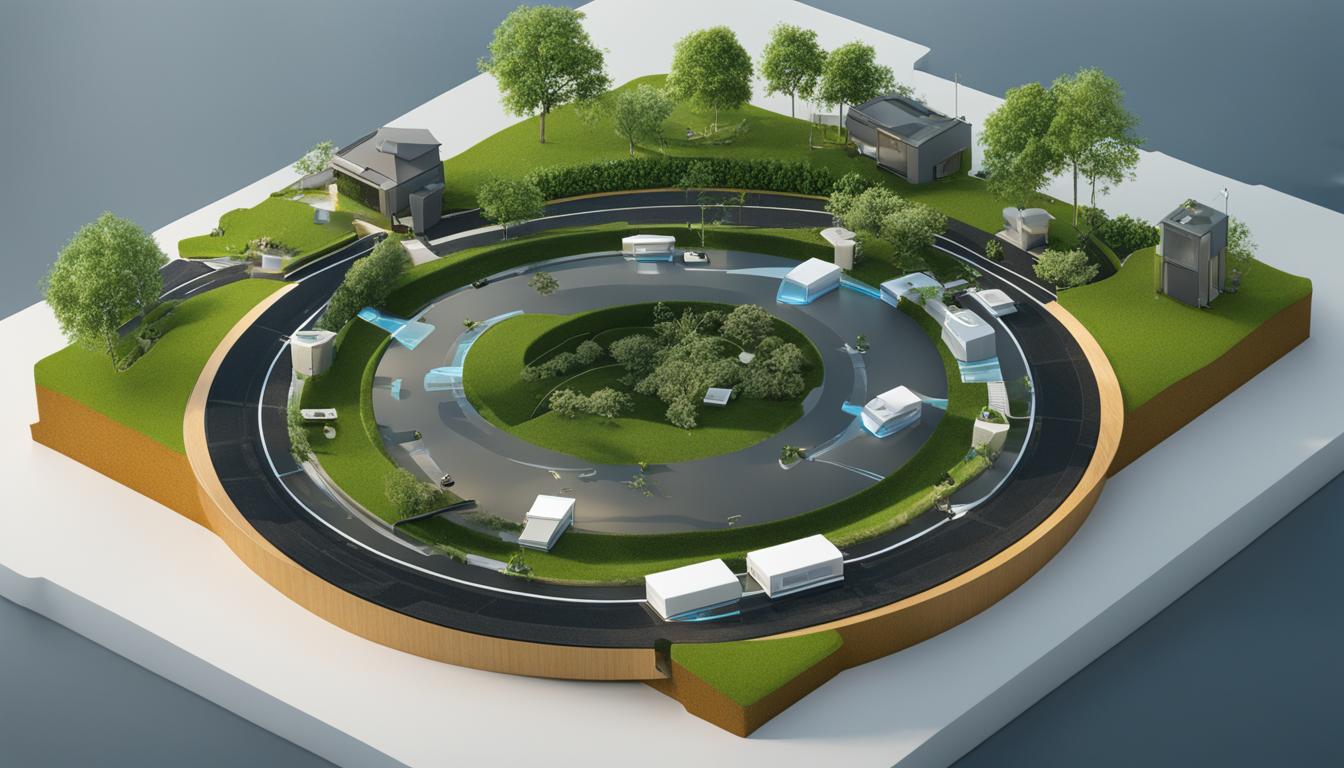Green IT: A Corporate Responsibility
Growth in population and economy is closely linked to social and environmental issues. Businesses’ stakeholders are increasingly concerned about the emergency of society and the environment. The legislation issue about environmental protection causes further pressure on businesses. Environmental related issues such as climate change, pollution, and greenhouse gas emissions have been well communicated to the community. The business world is making efforts towards socially responsible practices, improving environmentally performance, promoting innovations, and greening supply chains. However, more effort is necessary as environmental issues have not been sufficiently addressed at the enterprise level. Green strategy (GS) is introduced as a strategic solution to position and lead businesses towards sustainability based on respecting environmental and social issues. GS guides every decision made by the business on sound business logic and good sense. It is important for businesses and stakeholders, but further dynamic initiatives and actions are needed to achieve sustainable performance. CSR and green innovation are considered suitable to be associated with GS in affording sustainable performance. However, there is a dearth of empirical research evaluating the combination of GS, CSR, and green innovation.
Key Takeaways
- Green IT is a corporate responsibility and a focus on sustainable computing and eco-friendly technology
- Businesses need to adopt sustainable IT practices and environmentally conscious technology
- Green strategy, CSR, and green innovation can contribute to achieving sustainable performance
- There is a need for further research on the combination of GS, CSR, and green innovation
- CSR practices have a positive impact on promoting green innovation through enhancing green dynamic capability
The Importance of Green Strategy, CSR, and Green Innovation
Green strategy (GS) is a crucial aspect for businesses and stakeholders who are committed to sustainable performance. To achieve this, it is important to understand the relationship between green strategy, corporate social responsibility (CSR), and green innovation. While previous studies have individually examined the impact of CSR and green innovation on various aspects of business performance, there is a scarcity of research that collectively evaluates the role of green strategy in driving CSR and green innovation towards sustainable performance.
This study aims to fill this gap by examining the association between green strategy and CSR in promoting green innovation, with a specific focus on small and medium-sized enterprises (SMEs). Understanding how green strategy promotes CSR and green innovation is crucial for developing effective sustainable practices within organizations.
CSR and green innovation are expected to play a mediating role in the relationship between green strategy and sustainable firm performance. By exploring the interconnectedness of these factors, organizations can adopt a holistic approach towards sustainability, aligning their strategic decisions with environmental and social responsibilities.
Key Findings:
- Green strategy (GS) is important for businesses and stakeholders committed to sustainable performance.
- Previous research lacks an examination of the combined impact of GS, CSR, and green innovation.
- This study focuses on the association between GS and CSR in promoting green innovation in small and medium-sized enterprises.
- CSR and green innovation are expected to mediate the relationship between GS and sustainable firm performance.
“Understanding how green strategy promotes CSR and green innovation is crucial for developing effective sustainable practices within organizations.”
Table:
| Concept | Definition |
|---|---|
| Green Strategy (GS) | A strategic solution that positions and leads businesses towards sustainability by respecting environmental and social issues. |
| Corporate Social Responsibility (CSR) | An approach that focuses on a company’s commitment to acting ethically and contributing positively to society. |
| Green Innovation | The development and implementation of new practices, technologies, or products that prioritize environmental sustainability. |
| Sustainable Firm Performance | The ability of a company to achieve long-term success while minimizing negative impacts on the environment and society. |
The Link between CSR and Green IT
Corporate social responsibility (CSR) has evolved from philanthropic practices to a focus on societal expectations and building a sustainable living environment. Green IT, on the other hand, aims to achieve environmental sustainability and can be a part of CSR practices. The combination of CSR and Green IT strengthens the wave of achieving sustainability in society.
CSR practices involve not only minimizing negative impacts on the environment but also actively contributing to environmental improvement. Green IT aligns with this goal by promoting the adoption of eco-friendly technologies, energy-efficient computing, and sustainable IT practices.
One way to understand the link between CSR and Green IT is through the value model, which analyzes the stages of reaching the value of implementing Green IT and CSR. By incorporating Green IT into their CSR practices, companies can enhance their environmental performance, reduce energy consumption, and minimize their carbon footprint. This, in turn, contributes to the overall sustainability efforts of the organization and helps build a positive brand image.
| Stages of Value Model for CSR and Green IT Implementation | Description |
|---|---|
| Stage 1: Awareness | Recognition of the importance of CSR and Green IT in achieving sustainability goals. |
| Stage 2: Adoption | Integration of Green IT practices into CSR strategies and organizational processes. |
| Stage 3: Implementation | Execution of Green IT initiatives, such as energy-efficient infrastructure, virtualization, and cloud computing. |
| Stage 4: Transformation | Full integration of Green IT into the organization’s culture, leading to long-term sustainability. |
By adopting Green IT as part of their CSR initiatives, organizations can contribute to the global sustainability agenda while also reaping benefits such as cost savings, improved operational efficiency, and increased stakeholder satisfaction. The integration of CSR and Green IT sets a foundation for environmentally conscious practices and paves the way for a greener and more sustainable future.
Factors Influencing Corporate Green Innovation
The achievement of corporate green innovation is influenced by several key factors. These factors include market demand, stakeholder pressure, resource sharing, internal management, and macro environmental policy.
Market demand plays a significant role in driving corporate green innovation. As consumers and businesses increasingly prioritize sustainable products and services, companies are compelled to develop environmentally friendly solutions to meet these demands. By aligning their strategies with market trends, companies can tap into new opportunities and gain a competitive advantage.
Stakeholder pressure also plays a crucial role in shaping corporate green innovation. As society becomes more conscious of environmental issues, stakeholders, including customers, employees, investors, and regulatory bodies, are exerting pressure on businesses to adopt sustainable practices. This pressure creates a strong incentive for companies to invest in green innovation and develop environmentally responsible solutions.
Resource sharing and internal management practices are essential for fostering corporate green innovation. By collaborating with external partners and sharing resources and knowledge, organizations can leverage their collective expertise to drive innovation in sustainable technologies and practices. Additionally, effective internal management practices, such as establishing dedicated green teams and allocating sufficient resources, are vital for embedding green innovation within the organizational culture.
Finally, macro environmental policies also have a significant impact on corporate green innovation. Government regulations and policies, such as carbon pricing and incentives for renewable energy, create a favorable environment for companies to invest in green innovation. These policies provide clear guidelines and incentives for businesses to develop sustainable solutions and contribute to the transition towards a low-carbon economy.
| Factors | Description |
|---|---|
| Market Demand | Refers to the growing consumer and business demand for sustainable products and services. |
| Stakeholder Pressure | Includes pressure from customers, employees, investors, and regulatory bodies to adopt sustainable practices. |
| Resource Sharing | Involves collaboration with external partners to leverage collective expertise and resources for green innovation. |
| Internal Management | Encompasses effective management practices within organizations to drive green innovation. |
| Macro Environmental Policy | Refers to government regulations and policies that promote and incentivize green innovation. |
The Role of CSR and Green Dynamic Capability in Green Innovation
Corporate Social Responsibility (CSR) practices play a crucial role in promoting green innovation within organizations. By adopting CSR principles, companies can build trust with external stakeholders, form cooperative networks, and acquire innovation resources. These practices not only contribute to the development of a sustainable living environment but also foster the growth and success of businesses.
In addition to CSR, another important factor in driving green innovation is the concept of Green Dynamic Capability (GDC). Green Dynamic Capability, based on the theory of dynamic capabilities, refers to an organization’s ability to continuously revise and enhance its green organizational capability to adapt to a dynamic market. GDC acts as a mediator between CSR and green innovation, strengthening the promotion of environmentally friendly and sustainable practices.
Through the cultivation of CSR practices, companies are not only able to obtain innovation resources but also reduce innovation risks and save time and costs associated with the innovation process. This positive impact on green innovation can be attributed to the enhancement of green dynamic capability through CSR initiatives. By integrating CSR principles and actively developing green dynamic capability, companies can effectively drive green innovation and contribute to a more sustainable future.
Benefits of CSR and Green Dynamic Capability:
- Builds trust with external stakeholders
- Forms cooperative networks
- Acquires innovation resources
- Reduces innovation risks
- Saves time and costs associated with innovation
By leveraging these benefits, organizations can create a positive cycle of sustainable development, where CSR practices and green dynamic capability continually drive and support green innovation.

Table: Comparison of CSR and Green Dynamic Capability
| CSR | Green Dynamic Capability |
|---|---|
| Builds trust with stakeholders | Enhances green organizational capability |
| Promotes cooperation | Adapts to a dynamic market |
| Acquires innovation resources | Drives green innovation |
| Reduces innovation risks | Supports sustainable practices |
In summary, the combination of CSR and green dynamic capability is vital for driving green innovation within organizations. Through the adoption of CSR principles and the development of green dynamic capability, companies can create a sustainable business model that not only benefits the environment but also enhances their overall performance and success.
The Impact of CSR on Green Innovation
Corporate Social Responsibility (CSR) practices play a crucial role in driving green innovation within organizations. By enhancing green dynamic capability, CSR practices enable companies to obtain innovation resources, reduce innovation risks, and save time and costs associated with innovation. This positive relationship between CSR and green innovation is analyzed from an organizational capability perspective, emphasizing the importance of CSR in promoting sustainable and eco-friendly business practices.
CSR practices help companies build trust with external stakeholders and form cooperative networks, facilitating the acquisition of valuable innovation resources. By actively engaging in CSR initiatives, organizations can demonstrate their commitment to social and environmental responsibility, which resonates with eco-conscious consumers and enhances their reputation as a sustainable brand.
Furthermore, CSR practices contribute to the development of green dynamic capability. This capability refers to an organization’s ability to revise and develop its green organizational capabilities in response to dynamic market conditions. By actively integrating CSR practices into their operations, companies can adapt to changing environmental regulations and societal expectations, fostering a culture of innovation and continuous improvement.
The Role of Green Dynamic Capability
Green dynamic capability functions as a mediator between CSR and green innovation, as it enhances the promotion of green innovation. By developing the ability to adapt and evolve in the face of environmental challenges, organizations can effectively leverage CSR practices to drive innovation and achieve sustainable performance.
Overall, this section highlights the significant impact of CSR practices on green innovation. Through the cultivation and promotion of green dynamic capability, organizations can harness the power of CSR initiatives to drive innovation, improve environmental performance, and achieve long-term sustainability goals.
Conclusion
The study concludes that CSR practices have a significant positive impact on green innovation by enhancing green dynamic capability. The cultivation and promotion of green dynamic capability are crucial in the green development stage of manufacturing companies. This research fills a gap in the literature by providing insights into the impact mechanism of CSR on green innovation.
Companies that prioritize CSR can benefit from increased trust with external stakeholders, the formation of cooperative networks, and the acquisition of innovation resources. Moreover, green dynamic capability, which refers to the ability to adapt to the dynamic market by revising and developing green organizational capability, acts as a mediator between CSR and green innovation.
By understanding this relationship, companies can make informed decisions to promote green innovation through CSR practices. Investing in CSR not only helps companies obtain innovation resources and reduce innovation risks but also saves time and costs associated with innovation. The findings of this study offer valuable insights for organizations seeking to drive sustainable performance through green innovation and CSR.
FAQ
What is Green IT?
Green IT refers to the practice of using eco-friendly and energy-efficient technology solutions in order to reduce the environmental impact of computing.
Why is Green IT important?
Green IT is important because it promotes sustainability by reducing energy consumption, minimizing electronic waste, and implementing environmentally conscious technology solutions.
What is a Green Strategy?
A Green Strategy is a strategic approach that businesses can adopt to position themselves as environmentally responsible and lead towards sustainability by addressing environmental and social issues.
How does CSR relate to Green IT?
CSR (Corporate Social Responsibility) practices can be applied to Green IT initiatives, as they focus on societal expectations of corporate behavior and building a sustainable living environment.
What factors influence corporate green innovation?
Market demand, stakeholder pressure, resource and knowledge sharing between partners, internal management, and macro environmental policy are all factors that can influence corporate green innovation.
What is the role of CSR and green dynamic capability in green innovation?
CSR practices help build trust with external stakeholders, form cooperative networks, and acquire innovation resources. Green dynamic capability, on the other hand, refers to the ability to revise and develop green organizational capabilities to adapt to the dynamic market, thus enhancing the promotion of green innovation.
How does CSR impact green innovation?
CSR practices have a positive impact on green innovation by enhancing green dynamic capability, helping companies obtain innovation resources, reduce innovation risks, and save innovation time and costs.













